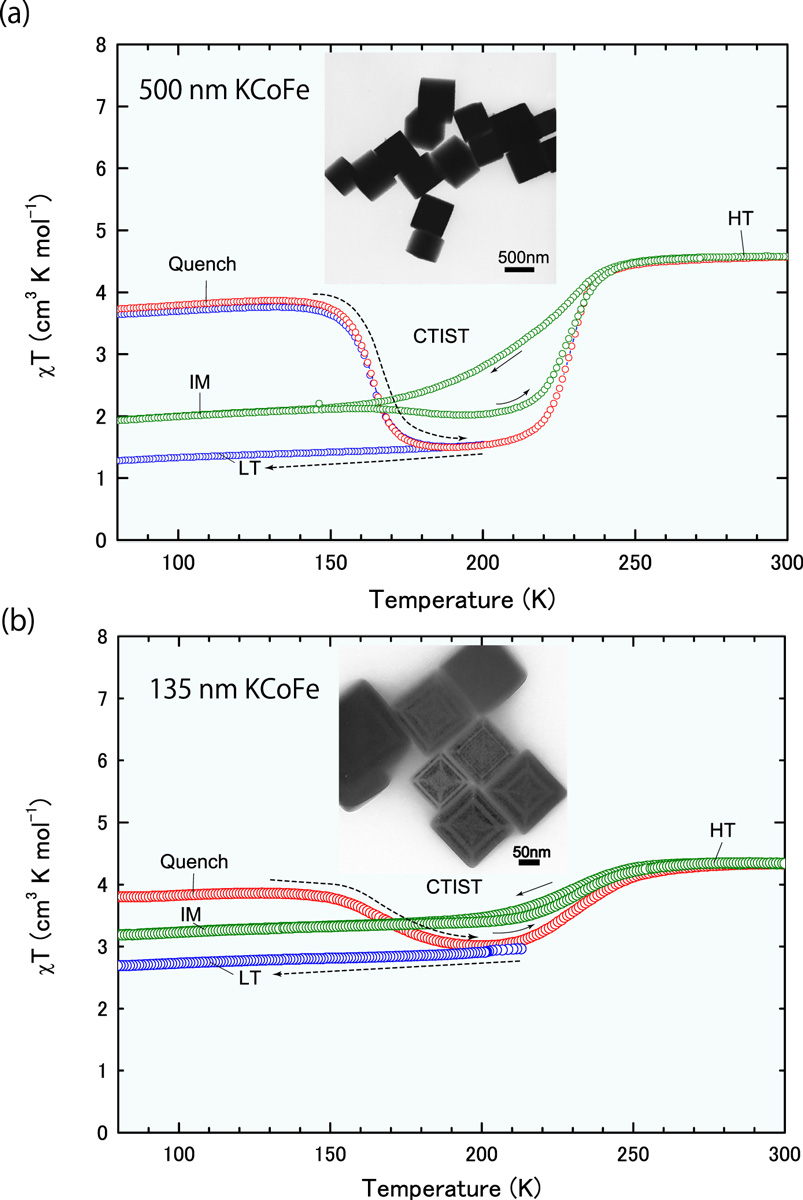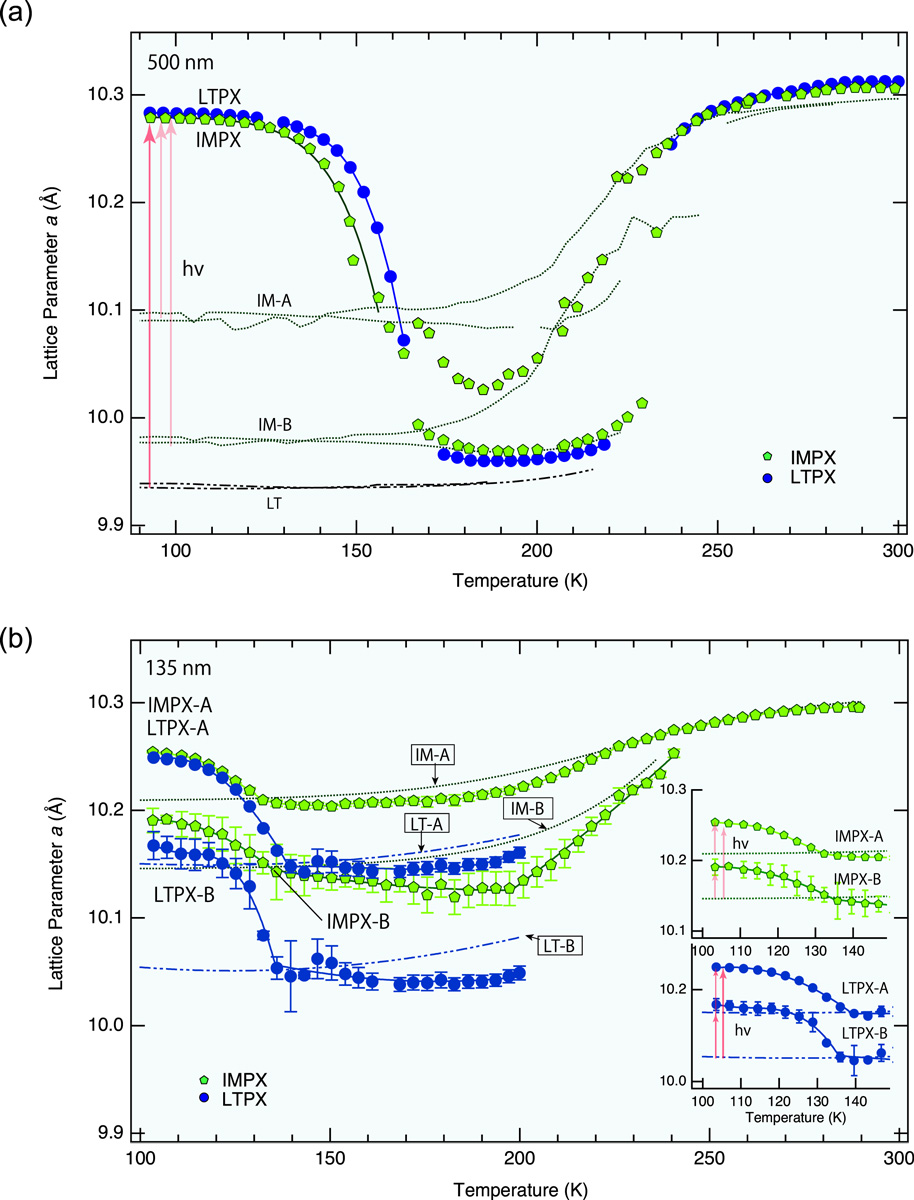Sub-Micron Particle Size Effects on Metastable Phases for a Photoswitchable Co-Fe Prussian Blue Analogue
PI of Joint-use project: M. Itoi
Host lab: Uwatoko Group
Host lab: Uwatoko Group
The K0.3Co[Fe(CN)6]0.77·nH2O compound undergoes a charge transfer coupled spin transition (CTCST), where spin configurations change between a paramagnetic CoII (S = 3/2)-FeIII (S = 1/2) high temperature (HT) state and a diamagnetic CoIII (S = 0) -FeII (S = 0) low temperature (LT) state. The compound having average particle size of 500 nm exhibits a unique intermediate (IM) phase that depend on the cooling rate. The IM phase corresponds to a mixture of IM-A (HT+LT fraction mixture) and IM-B (LT state), which have ~50 nm and ~200 nm coherent domain sizes, receptivity [1]. (Fig. 1) Moreover, several hidden metastable HT states emerge as a function of thermal and photo stimuli in the compound, namely: (1) a quench (Q) state generated from the HT state by flash cooling, (2) a LTPX state obtained by photoexcitation from the LT state derived by thermal relaxation from the Q state, and (3) an IMPX state accessed by photo-irradiation from the IM state [1, 2]. (Fig. 2(a))

Fig. 1. Magnetic susceptibility curves of K0.3Co[Fe(CN)6]0.77· nH2O for (a) 500 nm and (b) 135 nm particles. The thermally accessed Quench (Q) phase and Low-temperature (LT) phase are depicted as red and blue curves, respectively. The thermal procedure to reach the LT phase is indicated by dotted arrow. The IM phase is obtained by slow cooling (at 1 K/min). Differences in the thermal response as a function of particle size are observed in the hysteresis, becoming narrower with decreasing particle size. Insets: TEM images of the particles showing their clear cubic shapes.
A sample with smaller particle size 135 nm, which were designed on the scale of the coherent LT domains in the IM phase of the 500 nm sample [3], was investigated for by means of thermal and photo controlled PXRD and complementary magnetic susceptibility measurements, and an unusual IM phase and metastable HT phases in 135 nm particles of K0.3Co[Fe(CN)6]0.77·nH2O were compared to those of a similar sample with 500 nm particle size in the paper (Fig. 2). The incomplete character of the thermally-induced CTCST between CoII (S = 3/2)-FeIII (S = 1/2) and CoIII (S = 0) -FeII (S = 0) pairs becomes even less complete when the particle size is reduced from 500 nm to 135 nm. The HT spin CoII-FeIII states become predominant and the PXRD profiles suggest a multiphasic behavior, with a peak broadening larger than the one observed for the 500 nm sample. This behavior is attributed to HT domains or clusters made of a limited number of CoII-FeIII pairs that become constrained within the CoIII-FeII lattice at low temperature, which compose a multitude of CoII-FeIII clusters having different sizes and experiencing different elastic strains from the dominant CoIII-FeII phase. The multiple state in IM phase can be then viewed as a response of an inhomogeneous diluted system. In addition, the disordered character generated by CTCST in the 135 nm sample reflects to LT state obtained by thermal relaxation from a single Q phase and photo-excited states from IM and LT states, these metastable phases are always multiple states. (Fig. 2(b))

Fig. 2. Thermal decay of the lattice parameter a for photo-excited states IMPX (filled pentagons) and LTPX (filled circles) produced from IM and LT states, at 90 K for the 500 nm sample and at 100 K for the 135 nm sample. (a) Data related to the 500 nm sample extracted by the Le Bail method. The original IM state and LT state, which are the starting phases before 690 nm light irradiations, are indicated by the dotted and dot-dash lines, respectively. (b) Similar plots for the 135 nm sample extracted from (400) PXRD peaks. Inset: Expanded figures between 100 K and 150 K for temperature dependent photo-excited lattice parameters, IMPX-A & B (filled pentagons) and LTPX-A & B (filled circles) from the respective original states, IM-A &B (dotted lines) and LT-A & B (dot-dash lines).
Determination of the linear thermal expansion coefficients (LTEC) and pressure- dependent CTCST temperatures for the two (500 nm and 135 nm) particle sizes gave insights on the intrinsic stretchability and external compressibility, which were indicated that the bulk sample has higher flexibility at the CTCST, while the lattice change at the CTCST becomes less sensitive to external circumstances upon size reduction. We attributed these behaviors to the decrease of the cooperative electron-phonon coupling in small particles due to the enhancement of lattice defects which alters the elasticity of the small particles. The weak character of the elastic energy barriers produced during photoexcitation, combined with the disorder of elastic forces in the lattice, prevents the complete photoexcitation and the collective lattice change in the 135 nm sample. As a result, in the K0.3Co[Fe(CN)6]0.77·nH2O compound, photo-excitation under common values of power density does not change from the multiphasic IM state and/or LT state to a single metastable HT phase, through sub-micron scale particle size reduction [4].
References
- [1] C. Chong, M. Itoi, K. Boukheddaden, E. Codjovi, A. Rotaru, F. Varret, F. A. Frye, D. R. Talham, I. Maurin, D. Chernyshov, and M. Castro, Phys. Rev. B. 84, 144102 (2011).
- [2] M. Itoi, I. Maurin, F. Varret, F. A. Fry, D. R. Talham, D. Chernyshov, and K. Boukheddaden, Phys. Rev. B. 88, 094104 (2013).
- [3] M. J. Andrus, Y. M. Calm, E. S. Knowles, M. F. Dumont, K. A. Abboud, M. W. Meisel, and D. R. Talham, Polyhedron 64, 289 (2013).
- [4] M. Itoi, I. Maurin, K. Boukheddaden, M. J. Andrus, D. R. Talham, E. Elkaim, and Y. Uwatoko, J. Appl. Phys. 131, 085110 (2022)
